- Home
- Stephen E. Ambrose
Supreme Commander Page 12
Supreme Commander Read online
Page 12
One obvious solution to the disagreement was to compromise by combining the two plans, which was what Eisenhower did in his first meeting with the British planners. Together they explored the possibility of landings both “inside” (Algeria) and “outside” (Casablanca) and decided there was not sufficient shipping to do it simultaneously. Eisenhower therefore tentatively agreed to a plan that called for a landing by four divisions (two American) in the Mediterranean, to be followed by a later operation against Casablanca. Follow-up troops could enter the theater through either Casablanca or Algiers, or both, depending upon Axis reaction.20
On August 1 Marshall said he objected to sending four divisions through Gibraltar to Algeria, both because it was too large a force and because a troop movement of that size was sure to be spotted and the Allies would lose the element of surprise. Eisenhower, who never liked to cross Marshall, hastened to reassure the Chief. He said he had not made it “sufficiently clear … that the tentative and temporary plan outlined … represented exclusively the exploratory opinions of the British joint planners.” No one was willing to “express definite opinions” but the British, Eisenhower pointed out, disagreed with Marshall’s thought that the danger was Spain and the possible closure of Gibraltar. Even if Marshall was right, it would take the Germans weeks to establish airfields in Spain. Eisenhower himself felt that moving into the Mediterranean without protecting communications through Gibraltar was “a highly dangerous affair” and that Casablanca should be taken quickly. Eisenhower also passed on, without comment, the British view that the movement of a large convoy through Gilbraltar would not forfeit the element of surprise, since the Germans would assume it was headed for the Near East. The British also agreed that a simultaneous assault on Casablanca would be ideal, but lack of naval vessels precluded it.21
On August 9 Eisenhower submitted the first formal plan for TORCH. It called for an “approximately simultaneous” assault against the Mediterranean coast of Algeria and the west coast of French Morocco. The plan included landings at Oran, Algiers, and Bone, with an assault against Casablanca coming five to ten days after the inside landings.22
When Eisenhower sent the August 9 plan on to Marshall, who he knew favored more emphasis upon Casablanca, with at least a simultaneous landing there, he included a covering letter justifying the plan. He said that the attack against Casablanca would have to wait because of the lack of air cover. If he had had aircraft carriers available, Eisenhower added, he could make simultaneous inside and outside landings, but the carriers were not available and the only airfield he had was at Gibraltar. Its capacity was so limited that planes could not be passed through at a sufficient rate to meet minimum demands on both the north and west coasts. He could not build up the air facilities on Gibraltar beforehand, because “the airfield there literally lies on the Spanish border and there is no hope of concealing activity from spies and agents.”23
Marshall’s reaction was that without a simultaneous landing at Casablanca the operation had less than a fifty-fifty chance of success and was too risky. “A failure in SLEDGEHAMMER, for which the public has been adequately prepared, could have been accepted,” he explained, “but failure in TORCH would only bring ridicule and loss of confidence.”24
The British did not like the plan either, but they wanted to drop Casablanca altogether. In commenting on the August 9 plan, the BCOS said that the threat from Spanish Morocco was not serious and reiterated that not only were there not enough aircraft for simultaneous inside and outside landings, naval support was also insufficient. They then repeated that they were concerned about the early occupation of Tunisia. Eisenhower, commenting on the British paper, wrote in the margin, “The milk of the whole coconut.” Where the British declared, “We do not in any way wish to magnify the difficulties involved,” Eisenhower scribbled, “My God!”25
Eisenhower was closer to the British than to the American position. He warned Marshall that if the Germans beat him to Tunis “their later capabilities for building up strength will far exceed our own and will reduce the campaign to another futile and costly defensive venture.” This situation, Eisenhower said, “clearly calls for deferment of the Casablanca attack.” An added advantage of an inside attack only would be that he could push forward the assault date to October 7, and the British, like Roosevelt, thought the sooner the attack the better. Eisenhower concluded that he, Patton, Clark, and the staff agreed that this plan “represents the maximum degree of security, coupled with reasonable opportunity for attaining prescribed objectives, that can be developed out of the means and assets now in prospect.”26 Marshall was not at all happy with the prospect, but planning went ahead in London on the basis of no Casablanca operation.
Things were beginning to get well muddled. Later in the war, when everyone had more experience, a major amphibious operation needed a lead time of three to five months and a much larger staff than AFHQ had to work out all the details of troop and ship movement, air cover, naval support, assault objectives, D-Day movements, and so on. In 1942 the British and the President were urging Eisenhower to mount his attack in two months, this at a time when there was no high-level agreement as to immediate or final objectives, or even landing sites.
The lack of experience came forcibly to Eisenhower’s attention at this time; the first shipment of material for TORCH arrived in England without one crate or box properly labeled. His supply men had to go through every package, item by item, before AFHQ knew what was on hand and what was missing.27 On the day Eisenhower got the bad news that the navies could not provide enough ships for simultaneous assaults, he also learned that Rommel had been reinforced by two divisions. “The way things are going,” he complained, “the war will be over before we get in it!”28*
On August 14 Marshall asked Eisenhower for his “completely frank view” on the chances for a successful TORCH. Eisenhower replied with a long list of the difficulties and potential dangers, then concluded that he felt “the operation has more than fair chances of success provided Spain stays absolutely neutral and the French forces either offer only token resistance or are so badly divided by internal dissension and by Allied political maneuvering that effective resistance will be negligible.” He was not, however, hopeful about the French, so “the chances of overall success in the operation … are considerably less than fifty percent.”29 After composing the message Eisenhower walked with Butcher from 20 Grosvenor back to his apartment. Butcher said that as far as he could tell Marshall wanted to call the whole thing off. Eisenhower thought that was a real possibility.30
Two days later Eisenhower wrote one of his long personal letters to Marshall. He said time had been lost because the failure to establish clear command arrangements had made planning difficult. Once Clark had been appointed to command the planning staff, “a tremendous upsurge in progress has been noticeable.” When Clark set to work the shortages, especially in naval vessels and aircraft, began to show up. The staff began to wonder if it was all worth it. The objections the British had raised against SLEDGEHAMMER could now be applied to TORCH, especially the most important one—it might lead to disaster.
Eisenhower fought against the tendency to feel that TORCH ought to be dropped. “From the instant that I was authorized to assume executive charge of the proposition,” he assured Marshall, “I laid down a specific charge to all subordinates that the time for analysing the wisdom of the original decision had passed—that we were going to accept, without question, whatever the two governments could make available and that our problem was first to make the best possible plan within the framework of visible assets, then by leadership, organizing ability and intensive preparation to do all that lay within our power to insure success.” When Marshall asked for a frank evaluation, Eisenhower had dropped that attitude temporarily—thus his estimate of a less than fifty per cent chance of success. Clark and Patton had wanted him to add a statement that, regardless of that calculation, “we have no other thought except that of carrying this operation through
to the utmost of our abilities,” but Eisenhower had refused to add the sentence “on the grounds that you needed no reassurance of this particular kind; that unless you took these sentiments for granted you would not have named any of us to our present posts.”31
Marshall may have wished that Eisenhower would stall on the planning a little; the British were afraid that he was doing so. On August 19 Ismay told Eisenhower that Churchill, who was in Moscow to explain TORCH to Stalin, had been cabling often to say he wanted TORCH lit as soon as possible and that he expected “superhuman efforts.” Churchill had heroically taken it upon himself to tell the hard-pressed Russians that there would be no second front in 1942. To soften the blow, he pictured TORCH in glowing terms. Stalin was still unhappy, so Churchill wanted TORCH to be as big and as soon as possible. “I am sure that on his return he will expect to hear … all about the state of planning,” Ismay told Eisenhower. To reinforce the point the BCOS sent a formal note to Eisenhower, saying that they were aware of his difficulties and did not want to embarrass him, but that they were “extremely anxious to get the plan settled.…”32
Eisenhower and his staff had been working for hours every day and by August 21 had the new plan ready. It took into account the British objections to the August 9 plan and the lack of naval escorts. The objective was defined as an assault against Algeria “with a view to the earliest possible occupation of Tunisia.” The assault forces were to come in two convoys, one from Norfolk, Virginia, commanded by Patton, to land at Oran, and the other from the United Kingdom. Once inside the Mediterranean, the latter force would split, with the main force landing at Algiers and a small force going on to Bône.33
Eisenhower sent the plan to the British on August 22, along with a covering letter for Ismay. He told Ismay that in several ways the plan was tentative. The D-Day date of October 15 was probably too early since planning for the Patton force was not far advanced and too little was known about the schedules for U.S. convoys bringing men and equipment for the 1st and 34th Divisions to England. His available naval support continued to be cut, which required the reduction of the force to the point where it would no longer be strong enough to deal with the resistance the French could offer. Eisenhower said his personal opinion was that simultaneous landings inside and outside would make a great difference.34
General Handy, Eisenhower’s successor at OPD, had meanwhile arrived in London to take a close look at the plans. He provided Eisenhower with the first direct contact with War Department thinking he had had since Marshall left. Handy thought the whole thing much too risky. The British had continually emphasized the dangers involved in landing at Casablanca because of the heavy surf. Handy’s view, reflecting Marshall’s, was that it was better to take a chance on the surf at Casablanca than on the closing of the Strait of Gibraltar. He proposed that if sufficient naval vessels could not be found for simultaneous landings, then either Patton be sent to the Middle East to join the British there or the objective of TORCH be reduced.
Influenced by Handy, Eisenhower became more cautious. On August 22 Butcher noted, “Ike torn between desire to go ahead and do the job with the tools available and the necessity of stating his military belief that the assignment is ultra-risky.…”35 Eisenhower was not, however, impressed by Handy’s alternative of sending an American force to Egypt, since Marshall had already turned that down. He therefore tried to get the objective reduced. On August 23 he told the CCS that it was his opinion that TORCH was not “sufficiently powerful to accomplish … the purpose prescribed by the Combined Chiefs of Staff.” He explained why he felt that way, implied that if his forces could not be increased the objective should be decreased, but did not actually say he wanted to shift from an inside to an outside attack. He concluded with what amounted to a fervent plea to the CCS to look again and see if they could not find some more ships for him, so that he could launch a simultaneous assault. As long as the CCS directive made Tunis the objective, however, and his force was limited, he would stand by his August 21 plan.36
Eisenhower’s caution caused the BCOS to reconsider the whole operation. On August 24 they had a conference with Eisenhower and indicated that they too would like to make a simultaneous attack at Casablanca. The First Sea Lord commented that the British Navy was doing everything it could to provide Eisenhower with the ships he needed. Under the circumstances, Admiral Pound thought that the U. S. Navy “may be able to find additional escorting and supporting vessels so that the Casablanca attack might be staged along with those planned inside.” To get such help from the U. S. Navy, the British were willing to postpone the attack to November 7.37
This put it up to the U. S. Navy, which meant Admiral King. He said no. His fleet could barely hold its own in the Pacific with what it had, was deeply engaged in the Solomons, and had just lost one of its few operational aircraft carriers.
While the BCOS moved to new positions, so did the War Department. The same day that Eisenhower met with the BCOS, Marshall wired him to say that he was proposing to the CCS a new directive, limiting the objective to French Morocco and Oran. This would eliminate landings east of Oran. Marshall asked Eisenhower for his opinion. Eisenhower replied that, though it would “provide maximum possible degree of security,” it still risked bringing Vichy France and Spain into the list of active enemies “while it sets up no obtainable objective to balance either those risks, or the possibility of tactical defeat.…” The dangers were thus just as great but “we do not have a gambling chance to achieve a really worthwhile strategic purpose.” Eisenhower admitted that if the real purpose of TORCH was simply to get American troops into action at an early date, Marshall’s plan was preferable, but if the purpose was to take a tactical risk in the hope of gaining something worth while the Allies should go as far east as possible.38
Eisenhower was growing weary of the debate. After sending his message off to Marshall, he told Butcher that as he engaged in the frequent exchanges of messages he felt as if he was “in a transatlantic essay contest.”39 The British were willing to give Eisenhower Casablanca if King would provide the ships, but King would not. Marshall would not accept Algiers without Casablanca, while the British saw no point to the operation without Algiers. Eisenhower tended to side with the British, but without CCS agreement nothing could be done. It was like July and SLEDGEHAMMER versus TORCH all over again, and once again it was necessary for the heads of government to step in.
Churchill returned from Moscow on August 25. Eisenhower and Clark dined with him, and he talked all night. Eisenhower reported to Marshall that the “Former Naval Person feels completely committed to launching TORCH at the earliest possible date, on as grand a scale as possible and with ambitious objectives.”40
When Churchill felt strongly about something, few could resist him. He was an impressive sight, with his jutting chin, round shoulders, and fat cigar. With his cherubic face and bulldog head he was capable of portraying grumpiness incarnate. He was a great talker, able to switch moods instantly, crying one minute, laughing the next, engaging in a tirade immediately afterward. The Prime Minister was an accomplished actor who enhanced his ability to persuade through his thorough knowledge of the facts of a situation. He also never gave up. When the “Prime” got an idea into his head, he would argue for it until everyone with whom he came into contact was heartily sick of the subject. When his fertile imagination developed a new scheme and his professional subordinates did not immediately embrace it, he could be a most irritating person. He was well versed on military affairs, considered himself to be a military expert, and refused to accept the conclusions of his soldiers. He therefore meddled in every plan and operation of the war. He also would use whatever tools he could find to get his way. He knew that Eisenhower admired and liked him, and he never hesitated to use that knowledge to bring Eisenhower around when they had an argument. On the other hand the BCOS knew how Churchill felt about Eisenhower, so when they could not argue Churchill out of a project they would appeal to Eisenhower for help.
/> The two men had a number of violent disagreements during the war, but their friendship was never affected. Eisenhower later paid tribute to Churchill’s ability to forget the arguments once a decision had been reached: “… in countless ways he could have made my task a harder one had he been anything less than big, and I shall always owe him an immeasurable debt of gratitude for his unfailing courtesy and zealous support, regardless of his dislike of some important decisions.”41
Churchill’s hours were strange and all those who served with him had to adjust. His day began late and ended in the small hours. The evening Eisenhower and Clark dined with him they talked about TORCH, and all the back-and-forth planning that had gone on, well past midnight. Churchill snorted that it was ridiculous to think that Franco would enter the war and said the Americans were making too much of the Spanish threat. Eisenhower agreed with him.42
Churchill suddenly decided, around 1 A.M., that he had to talk to Pound and Mountbatten, so he called them in for the conference. When they arrived, rubbing their eyes, he told them to cut down the time element in preparing the British contingent for TORCH so that it could go by mid-October. Shaking his finger at Pound, he said the Royal Navy would have to bring back to England “every available piece of equipment.” Since the U. S. Navy was so heavily engaged in the Pacific, he told Pound, he was perfectly willing to strip the Indian Ocean to give Eisenhower more escort vessels. Turning to Eisenhower, he said that if necessary he would fly to Washington to convince Roosevelt and Marshall of the need to get TORCH moving. He wanted it started by October 15, and wanted Eisenhower to go beyond the August 21 plan and land as far east as Philippeville. The next morning Eisenhower summed up the results of the meeting for Marshall, then added in an understatement, “He is putting his tremendous energies and enthusiasm behind the project.…”43

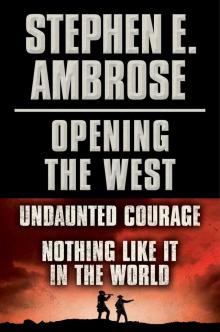 Undaunted Courage
Undaunted Courage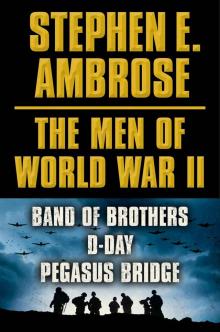 The Victors: Eisenhower and His Boys
The Victors: Eisenhower and His Boys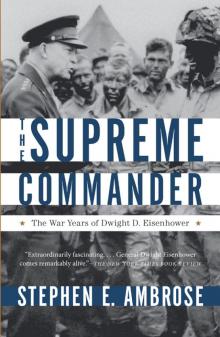 The Supreme Commander
The Supreme Commander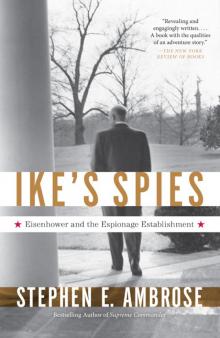 Ike's Spies: Eisenhower and the Espionage Establishment
Ike's Spies: Eisenhower and the Espionage Establishment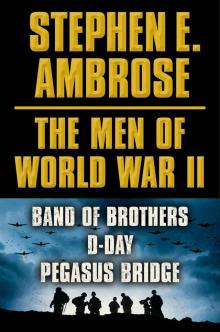 The Men of World War II
The Men of World War II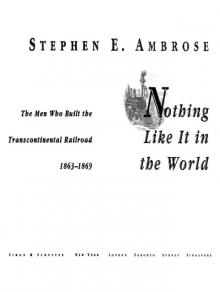 Nothing Like It in the World The Men Who Built the Transcontinental Railroad 1863-1869
Nothing Like It in the World The Men Who Built the Transcontinental Railroad 1863-1869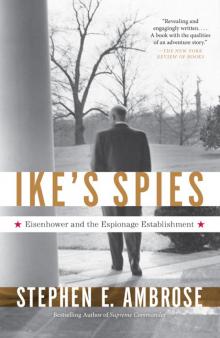 Ike's Spies
Ike's Spies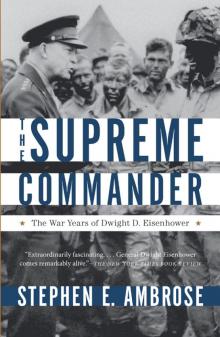 Supreme Commander
Supreme Commander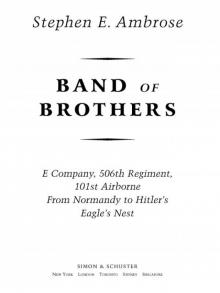 Band of Brothers
Band of Brothers